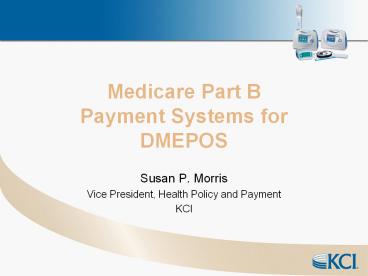Medicare Part B Payment Systems for DMEPOS - PowerPoint PPT Presentation
Title:
Medicare Part B Payment Systems for DMEPOS
Description:
Provides therapeutic benefits or enables the beneficiary to function with ... Bed frames, walkers, wheel chairs. No need for physician prescription ... – PowerPoint PPT presentation
Number of Views:18
Avg rating:3.0/5.0
Title: Medicare Part B Payment Systems for DMEPOS
1
Medicare Part B Payment Systems forDMEPOS
- Susan P. Morris
- Vice President, Health Policy and Payment
- KCI
2
DMEPOS
- Durable Medical Equipment
- Provides therapeutic benefits or enables the
beneficiary to function with certain medical
conditions and/or illness - Prosthetic and Orthotic Devices
- Replaces all or part of an internal organ or
replaces the function of an internal organ - Supplies
- Surgical dressings and casts
- Supplies used with DME
3
DME Reimbursement Problems
- Eligibility in the home
- HCPCS Coding
- Implications for Competitive Bidding
- Payment structure
- Capped rental payments
- Gap filling
- Coverage
- Artificial criteria based on payment structure
4
Eligibility of DME in the Home
- Available only in the home not institutional
homes - Based on routine DME available in 1970s
- Bed frames, walkers, wheel chairs
- No need for physician prescription
- Owned and reused by facilities
- Does not take into account development of
ancillary technology - Prescribed for specific conditions
- Equipment not generally purchased by facilities
- Problem 1 Patients who live in nursing
facilities are denied access to
ancillary DME - Solution Demonstration project leading to
legislation expanding the benefit
5
HCPCS Coding
- DME is classified with Level II HCPCS codes
- Permanent codes assigned by national panel
- Temporary codes may assigned by Medicare
contractors, Medicaids, private plans (BCBS) - No customization of codes or modifiers allowed
after HIPAA implementation 10/03 - HCPCS codes are the basis for payment
- Fee schedules today
- Competitive bidding beginning in 2007
6
Problems with HCPCS
- Problem 2 Coding system is biased against
addition of codes. New, advanced technologies are
often assigned to existing codes creating
significant technology gaps between products
meeting minimum specs within the code and those
which significantly exceed them. - Problem 3 If codes with technology gaps are
competitively bid, winning bids are likely to be
based only on the less expensive products
meeting minimum specifications and the payment
will be so low that advanced technologies
previously included in the code will no longer be
available to patients and caregivers. - Solutions a) Plan for expanded code set
- b) Better definition of coding review criteria
- c) Only bid tightly defined
codes
7
DME Payment
- Six Point Plan adopted in 1987
- Inexpensive or routinely purchased
- Items requiring frequent and substantial service
- General prosthetic an orthotic devices and
miscellaneous supplies - Capped rental items
- Oxygen (rental) and oxygen equipment
- Customized equipment (including prosthetic and
orthotic devices)
8
Capped Rental Equipment
- Definition
- Not routinely purchased
- Not service intensive
- Not customized
- Not oxygen
- Paid monthly rate, never prorated for shorter use
- Amount which is approximately I/10th of the
purchase price - Calculated through gap filling from 1987 to
present - Up to 13 months then title transfers to patient
(Deficit Reduction
Act of 2006) - After transfer Medicare pays 80 of reasonable
and necessary service costs
9
Problems with Capped Rental
- Problem 4 Sampling errors used to calculate
baseline for gap filling can skew payment either
high or low. - Solution(s) a) Eliminate technology gaps
- b) Better define sampling methodology
- Problem 5 Payment for capped rental is based
on purchase price and does not account for
caregiver/customer education, administrative
costs with complicated claims requirements or
product maintenance necessary to ensure safe,
appropriate use - Solution Develop a new payment mechanism for
ancillary technologies
10
Payment Vs. Coverage
- Problem 6 Because only one payment can be made
for a single month - a) Some medical policies require that a product
be used for the full month before an alternate
product could be used, even if there is evidence
that the first product did not meet the patients
needs. - b) If a second supplier provided a replacement
product during a month that has already been
paid, the second suppliers claim will be denied
as not covered and the first supplier will be
paid for the full month regardless of how long
the patient used the first product. - Solutions a) Dont require a failed product to
be used for an entire month and - b) Adjust payment for that month to
reflect the fee schedule of the higher
of the two used products.
11
SUMMARY
- Many of the significant problems with DME
reimbursement systems could be resolved
with the following
two changes - Create an ancillary DME category
- Expand the benefit to nursing facilities
- Create a new payment system
- Redefine the HCPCS coding process to increase
predictability and transparence
12
Thank you!
- Susan P. Morris
- Vice President, Health Policy and Payment
- KCI, San Antonio, TX
- Morriss_at_kci1.com































